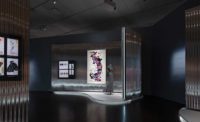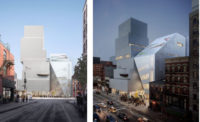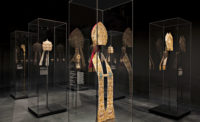Manus x Machina at the Met by OMA New York
New York City

The rotunda displays a neoprene wedding dress by Karl Lagerfeld. Details of the pixilated pattern on the gown’s train are projected onto the dome’s opaque blackout fabric via 3-D mapping.
Photo © Albert Vecerka/Esto

A diaphanous scrim reveals the structure throughout the installation, where garments are arranged in niches around the rotunda.
Photo © Albert Vecerka/Esto

A diaphanous scrim reveals the structure throughout the installation, where garments are arranged along parallel rows on the lower level.
Photo © Albert Vecerka/Esto

Located on the museum’s central axis in the Robert Lehman wing, the exhibit is visible as museumgoers approach it through the Medieval Court.
Photo © Albert Vecerka

3-D-mapped projections magnify details on the dresses within several niches surrounding the rotunda.
Photo © Albert Vecerka

A side gallery on the lower level showcases the foundations of tailoring and dressmaking.
Photo © Albert Vecerka

The rotunda leads directly toward a gallery on the west side of the building where glass-encased case studies of feathered garments are on display.
Photo © Brett Beyer

Exposed structure between the central rotunda and surrounding galleries is visible over the stairs down to the lower level exhibition space.
Photo © Brett Beyer

Upper level plan.
Courtesy OMA

Lower level plan.
Courtesy OMA

Axonometric drawing.
Courtesy OMA

Full section.
Courtesy OMA












Architects & Firms
Scores of paparazzi and fashionistas jammed the entrance of New York’s Metropolitan Museum of Art on May 2 to glimpse the celebrities attending the 2016 Costume Institute Gala, a red-carpet fundraiser heralding the opening of the Institute’s exhibition Manus x Machina: Fashion in an Age of Technology. Yet while some guests were provocatively dressed in sync with the show’s theme (Beyoncé wore a skintight latex affair by Givenchy), none had the sheer impact of the exhibit itself, housed in a haunting environment designed by OMA New York in collaboration with Andrew Bolton, the curator in charge of the Costume Institute.
On view through August 14, Manus x Machina examines how designers balance traditional handwork with machine- and computer-driven technologies in the creation of haute couture and avant-garde ready-to-wear fashion. The 18,300-square-foot installation, centrally located in the Robert Lehman Wing—a bilevel bump-out on the museum’s west side—is stunning in its simplicity, providing a cocoon-like enclosure for the showcasing of Bolton’s 170 extraordinary case studies, which date from the late 19th century to the present.
The program requires visitors “to focus on the details and garments themselves,” says OMA New York director Shohei Shigematsu. “In order to do that, we had to create a neutral environment, so that the clothing stands out.”
Led by Shigematsu, the design team devised a scaffolding system, tautly veiled by scrim textile, in the given space—a run of narrow galleries on each of the two floors, octagonal in plan, with a skylit atrium on the upper level. At its heart, they built a rotunda (43 feet in diameter and 52 feet high), topping it with a shielded truss dome that blocks the sun from the existing skylight. Two series of arcades—one surrounding the rotunda, the other below the first—feature displays organized by specific skills of fine dressmaking, such as pleating, embroidery, lacework, and so on.
Dubbed “Ghost Cathedral” by the architects, the ephemeral structure-within-a-structure is revealed or concealed, like a stage set, depending on how it is lit. “So while you’re circulating, you can always see another space,” Shigematsu notes. “It is never claustrophobic.” Nor is it overwhelming. The architects’ sparing use of electronic media is limited to 3-D-mapped projections that magnify exquisite details of dresses in the rotunda and its adjacent niches—most notably a close-up in the dome of a golden pixilated pattern, hand-painted and embroidered, on the train of a Chanel wedding gown by Karl Lagerfeld.
Shigematsu wanted the experience to be unexpected, he says, “to focus on the pristine details and to treat them like art.”
PeopleArchitect:
OMA New York Personnel in architect's firm who should receive special credit:
Partner in Charge: Shohei Shigematsu Engineers: Arup (all) Consultants
Lighting: Dot Dash Photographer: Naho Kobuta / Brett Beyer, Floto + Warner, Albert Vecerka / Esto
|
ProductsStructural System Scaffolding Manufacturer of any structural components unique to this project: UBS Exterior Cladding Masonry: Manufactured by CW Keller Other cladding unique to this project: Scrim/Membrane fabricated by Newmat Interior Finishes Resilient flooring: Steel scaffolding structural system with plywood subfloor and rubber finished floor surface. |
















